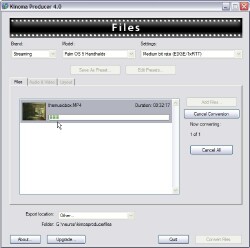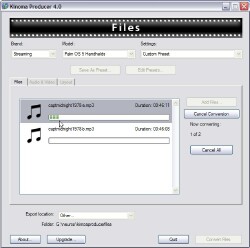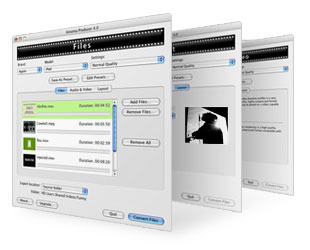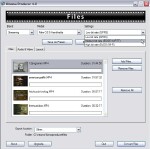

|
|
|
| Thu Sep 20, 2007 - 10:21 AM EDT - By Harv Laser | |
|
|
|
|

Due to the complexity of video and audio encoding, and all that it entails, even though Kinoma Producer 4 was specifically designed to make the task ridiculously easy, (which it does), and with that ease comes beautiful results, it also offers a lot of options for manual tweaking "under the hood" for those who want to fine tune its output, so this review grew to a length where I thought it best to break it into two parts.. you can (and should) read Part One here first..
What follows is a Q&A session I had with one of Kinoma's execs � I wanted to ask him a few questions about its operation which were not immediately obvious to me, and which the manual didn't completely spell out. When writing reviews, my long-time goal has always been to operate under the assumption that if I'm not sure about this or that detail, many readers who buy a product under scrutiny may not be sure either. In other words, I strive to answer your questions before you have to seek out the answers yourself. Following our exchange, you'll find the review's conclusion, and my ratings of the product.
But first, one additional point I'd like to make - I'm sure some readers will think "fooey, I've got a freeware program written by some guy in Russia that does the same thing and didn't cost me a cent." While that's entirely possible, bear in mind that if you buy Producer for $29.99, you're not just getting a piece of software and left to flounder around on your own trying to figure out how to use it, or have to go on a wild goose chase to track down "that guy in Russia" who wrote a freeware program in his spare time if you run into problems.. you're getting world-class support from a well-established, highly-respected company, along with their product. A company who not only sells outstanding consumer-level programs that, in my opinion, are a steal for the money, but a company whose video and audio code is even embedded in products made by Sony, Palm, eMusic, Autodesk, Jaman, and Sling Media, to name a few. Plus, you get fast email support answers, and Kinoma's Online Forums. Those of you who have dealt with Kinoma should know exactly what I'm talking about. A real company with a professional staff of experts, not some "kitchen table" coder who whipped out a program and vanished.
So without further ado, here's my Q&A with Kinoma, aimed at filling in some knowledge gaps..
ME: From what I can discern, one cannot load multiple source movies into Producer, and set different output parameters for each one.. is that correct?..
KINOMA:Correct.
ME: in other words, suppose I want to convert the SAME input file, call it "movie.mp4", and output it in three different resolutions, or three different frame rates, or one Stereo and the other two Mono, or whatever.. maybe I want to do this so I can experiment which settings produce the best results when I upload all the output files to my server and then stream them in Kinoma Player.. but.. it appears that if I have more than one input file loaded into Producer's interface and I change the output parameters on one of them, it changes the output parameters on the others automatically, so that ALL the input files have the SAME output parameters.. is that the expected behavior for the program?..
KINOMA:Yes. The idea is that as an end user with typically one target device, you would take a number of files and change them to be used on your specific device, not to target all of your friends' devices at the same time. In consumer software you are going for simplicity
ME: such that if multiple input files are loaded and you set output parameters for them (pixel dimensions, frame rate, bit rate, Stereo or Mono, type of file, whatever..) .. that those multiple files loaded into its interface for processing cannot EACH have different output parameters.. change one, and the others, no matter how many there are, automatically change so that they're all the same.. is this the way it's supposed to work?..
KINOMA:Yes.
ME: soooo.. if you want to convert a file three different ways, you literally have to run it through Producer three separate times, changing the output settings with the program's tab system each time..
KINOMA:That is correct. But for $500.00 or more, you can have that convenience of doing it all from a single set up with the examples above. Believe me it is very complex to use those (pro) interfaces. Get a review copy and see.
ME: what i also wanted to try was to load the same .mp4 file into Producer multiple times in one go.. which it wouldn't let me do.. so i made copies of the same .mp4 file and gave each one a different name on my hard drive.. exact same .mp4 file, different file names, loaded all three of them in.. since Producer then thought they were three different movies, it loaded and displayed thumbnails of all of them.. then i messed around with changing the output parameters for the first one (knocked it down from 30fps to 15fps but left it 320 x 240).. then i highlighted the second one, and changed ITS output parameters to 160 x 120 and when i went back to the files tab and looked at the first one, it too had been changed to 160 x 120.. so.. you can't load a bunch of files for batch processing and give them different output settings.. change one, it changes all the others to match.. right?..
KINOMA:Absolutely.
ME: in the upper right hand corner of Producer's interface are some pre-sets for what kind of network you want to stream from.. low bit rate, medium bit rate, and high bit rate.. my Treo 700ps are on Sprint's EVDO network, thus high bit rate.. so i tried converting a half hour Laurel and Hardy short which is an .mp4 file, 320 x 240, 30fps, to 15fps, thinking by halving the number of frames but leaving everything else alone.. and uploading the results to my server, it would stream more smoothly and not go into slideshow mode.. i left that Producer pre-set to high bit rate.. but it did not produce smoother results when I uploaded the file and streamed it in Player.
KINOMA:I believe you. The network variations are high. The 1xRTT preset will give you good results most of the time on EVDO and 1xRTT. If you use the EVDO setting it will give you good results most of the time on Wi-Fi and some of the time on EVDO. Use GPRS for AT&T networks.
The FPS (Frames per Second) is not the only consideration, look at the bit rate. While the tab is open to audio / video, you can change the presets and see how the settings change. Do the same with the layout tab open too. All the factors count.
ME: then i tried another experiment.. i took a four minute scene, an .MP4 from a film i had digitized with my Neuros recorder, loaded it into Producer, and told it to cut it down from 320 x 240, 30fps, to 160 x 120, 15fps, and instead of using the preset for high bit rate (EVDO / WiFi), I used the preset for medium bit rate (GPRS / 1XRTT).. Producer processed that short segment of film, I uploaded it to my server, and streamed it.. this worked beautifully.. although the file plays quarter screen when i stream it off the server with Kinoma Player 4 EX, i can use the Player's little "+" icon and bump it up to full screen, and it plays smoothly and NEVER goes into slide-show "thinning" mode.. although it looks a bit pixellated as i would expect, when blown up to full screen.. then again, from a foot away it looks beautiful.
So my second experiment produced totally satisfactory results.. and if I did the same with a full-length two hour feature film as i did with that four minute segment of a film, I would get similar streaming results: smooth, full-motion playback.. (although a two hour film would take a lot longer to buffer up and start playing than a four minute segment of a film).
Also, since you designed Producer's interface so that different controls and information are on three different tabs, one cannot see all the output settings at once.. you have to tab around to see what the pull-down pre-sets have done.. right?
KINOMA:Correct. Remember the design point. The typical consumer will never look under the covers. 95% of Producer users NEVER operate these tabs. The ones that do make massive numbers of trial samples and save custom presets when they finally get what they want.
ME: So, changing those three pre-sets in the upper right hand pull-down change the output settings to what the program thinks are the best settings for those network speeds.. BUT one could leave that pulldown alone and achieve exactly the same thing by tabbing into the settings and changing them manually, right?.. in other words, Producer has a kind of "novice mode", and an advanced mode.. novice mode: use the pull-down and change it from high speed network to medium speed network, and it changes a bunch of settings. Advanced mode: leave that pull-down alone, and go in and manually set the output file to the SAME settings as the pull-down would create, and you get the same results, right?..
KINOMA:Yes. You can create the same output settings manually. Kinoma has done the basic footwork for you to take advantage of. Just make your "own" labels.
ME: so (as I slipped into my rubber Nixon mask).. I just want to get this perfectly clear:
1) - all movies loaded simultaneously into Producer will be output with the same settings..
KINOMA:Correct. And to my earlier point, allowing a consumer this flexibility would require a much more complex user experience, which is not who our customer is. Download a trial of the two pro examples above. See if you can set up and bang out a 1 minute file without keeping your nose in the manual for less than an hour.

ME: 2) - the network speed pull-down changes a bunch of parameters.. BUT you can tab your way into those settings and change them manually instead and achieve the same thing the pre-sets do..
KINOMA:Absolutely.
ME: as far as what you said about how long it takes to process a file on a 1.5ghz computer, mine is 2.1 ghz (max speed).. that it would be "about real-time" i found this to be pretty much the case.. a half-hour .mp4 took about half an hour to process.. you don't provide a time-to-completion counter, instead you use a segmented progress meter, so one doesn't really know how long until it'll be finished except by watching the segments.. i also noticed that every time i used it, i didn't really have to wait until the progress meter or gas gauge totally reached its end.. it seems like Producer finished, and wrote the output file a few segments before the gauge reached its end.. it'd be nice if the program had a "how long?" countdown timer in it as well as the segmented gas gauge..
KINOMA:We looked at this. It turns out that like everything else in computing it's a lot more complex than you might think to produce something like that. As soon as a consumer decides to do another foreground task, like email or do some web browsing, all of this changes dramatically. Producer is actually doing some clean up in that time where you think it was doing nothing, so it's not a good idea to skip waiting to the end. The file may become corrupt if you don't allow the process to finish completely.
There are other tidbits in the manual that are not obvious like the command line mode for those who want to write text scripts and have Producer do batch conversions of many files.
I had a short wmp-2 video that I'd downloaded years ago. TCPMP played its video but has no codec to handle its audio. Kinoma Player wouldn't play it at all. I ran it through Producer and converted it to an MPEG-4, uploaded it to my private server, fired up the Player, and streamed it. Voila � perfect results. Video AND audio, smooth as silk. The whole process took under ten minutes. Blew me away.
You can download Kinoma Producer 4's manual and read it here and there's also an FAQ here.
If you want to mess around with the trial version of Producer, and you don't have any short videos handy, you can grab some with your computer, from Kinoma's Gallery here or their Mobile gallery to reach from the Treo here.
Directly download Kinoma Producer Trial version here.
Copyright 1999-2016 TreoCentral. All rights reserved :
Terms of Use : Privacy Policy
TREO and TreoCentral are trademarks or registered trademarks of palm, Inc. in the United States and other countries;
the TreoCentral mark and domain name are used under license from palm, Inc.
The views expressed on this website are solely those of the proprietor, or
contributors to the site, and do not necessarily reflect the views of palm, Inc.
Read Merciful by Casey Adolfsson